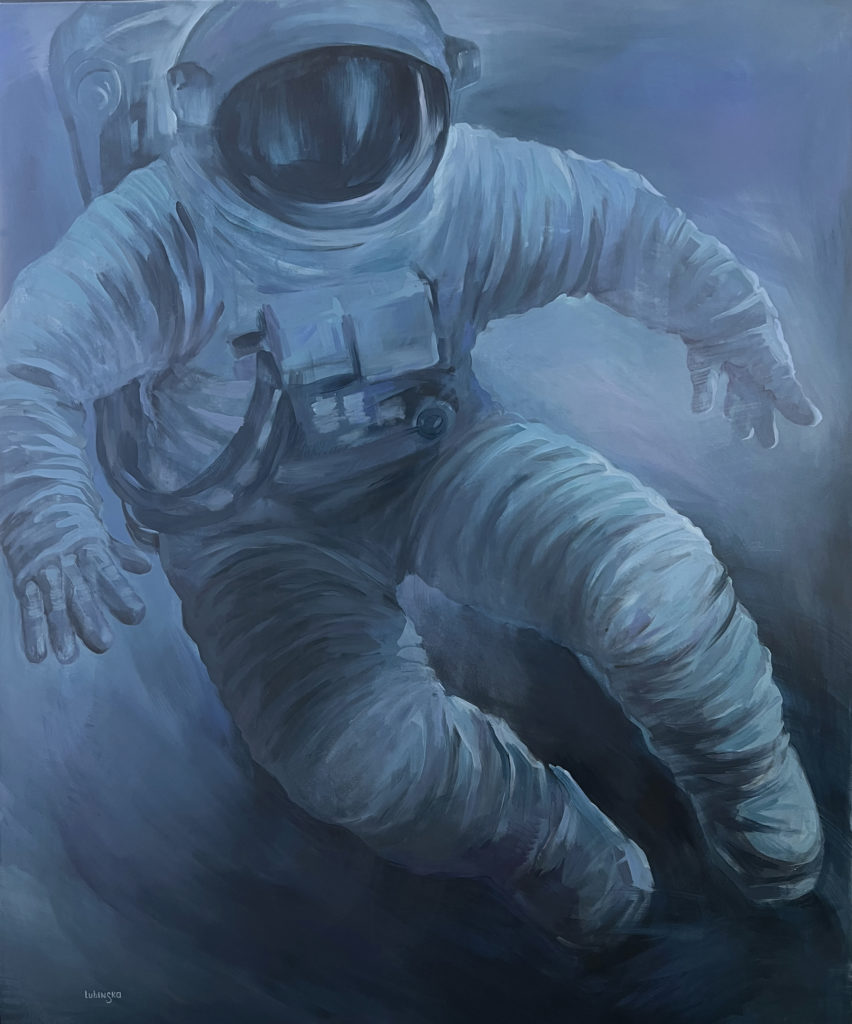
“HOMO ASTRALIS”
2025
Modified acrylic on canvas
100 x 120 cm
In Homo Astralis, Victoria Lubinska-Felix returns to one of the most essential questions of the space age: what remains human when we leave the Earth?
At a time when astronauts are often portrayed as symbols of post-human transformation, this work brings the story back to its origin — to the person inside the suit, breathing carefully, sustained by fragile systems, yet moving forward into the unknown. Lubinska-Felix does not depict an abstract emblem of progress or destiny; she reveals a human being who dares to begin. The astronaut is not beyond humanity — he is its continuation, the one who carries forward the pulse of life into places where it was never meant to exist.
Suspended within the deep field of blue, the figure drifts — alone, but never lost. His solitude carries the collective weight of everyone who has ever looked upward and dreamed. In this floating body, we sense the paradox of our species: fragile flesh enclosed in the brilliance of engineering, a heart beating within machinery designed to keep it alive. Yet nothing here feels mechanical. The stillness around him hums with quiet resilience, as if the silence itself were listening.
Homo Astralis is not a symbol of escape but of endurance. His isolation is not exile; it is initiation — the first step toward belonging to something larger than Earth. He embodies the courage of those who accept distance as the cost of discovery, who transform separation into continuity. The reflective helmet hides his face, but in that mirrored surface, we glimpse our own. He becomes us — multiplied, projected, evolving — a vessel for the collective dream of survival beyond the limits of the planet that made us.
Within the framework of IMMORTALIS CONTINUUM, Homo Astralis stands as the first act of faith in the human continuum. He is the beginning of an unbroken thread that stretches from organic life to post-organic consciousness, from atmosphere to vacuum, from body to idea. He is not yet hybrid, not yet divine — only human, and therefore infinite in potential. His quiet persistence becomes a form of prayer, not to gods above, but to the possibility that humankind itself may endure, adapt, and remember.
Through him, Lubinska-Felix restores to the cosmic narrative what it so often loses — the beating heart of the traveler.
And in that steady rhythm, we recognize the first true note of the Immortalis Continuum — the moment when one fragile human, floating in silence, becomes the origin of everything that will follow.
Shared Continuum Note (Concise Version)
Within IMMORTALIS CONTINUUM, Homo Astralis and Refraction form two movements of the same evolutionary passage. The first embodies the courage of the human form entering the unknown; the second, the acceptance of transformation within it. Each reveals that immortality lies not in preservation but in adaptation — in the continuity of consciousness beyond its former boundaries.
The astronaut, whether whole or refracted, remains a vessel of endurance, memory, and expansion. His shifting form reflects the unbroken thread of human existence as it extends into the cosmic field. Through these works, humanity is not diminished by the infinite; it learns to coexist with it — evolving, reframing, and continuing as part of the vast, unfolding continuum.